Southern wilt, caused by the bacterium Ralstonia solanacearum (Rs), is currently an important disease for geranium producers. Different races of R. solanacearum affect hundreds of plant species around the world. However, some races are specific to given areas and are adapted to different climates. Race 1 biovar 1 is well adapted to tropical and warm-temperate areas and is common to the southeastern United States. Another race of R. solanacearum, race 3 biovar 2 (RsR3b2), is not endemic (occurring naturally) to North America. Although RsR3b2 is also tropical in distribution, this race is more cold tolerant and poses a threat to the US potato industry. Race 3 biovar 2 has only been detected in a few greenhouses in the US and has been eradicated in each case.
Both race 1 and race 3 are capable of causing southern wilt disease on geranium. In an attempt to keep RsR3b2 from being introduced on imported geraniums and other susceptible crops, APHIS PPQ regulates potential introductions and has the authority to quarantine and destroy plants found to be infected. Geranium plants infected with the common R. solanacearum race 1 look identical to those infected with race 3. Geranium growers have a zero-tolerance for R. solanacearum, because it is likely that the discovery of any race on geranium will result in costly complications for the grower. This publication is meant to provide information to geranium producers that might help reduce their risks of substantial losses due to southern wilt disease.
Pathogen and Disease Information
Host Range
Plant species most susceptible to RsR3b2 include potato, tomato, geranium, and a few solanaceous weeds. Race 1 has a wide host range that includes potato, tomato, geranium, eggplant, pepper, tobacco, peanut, banana, and many others. Numerous solanaceous weed species associated with open irrigation systems or in close proximity to the production facility could potentially serve as a source of R. solanacearum inoculum. The exact host range of the pathogen is difficult to determine because of variation in virulence within races of R. solanacearum and variation in susceptibilities of host species. Some plant species may be asymptomatic but can still harbor the pathogen.
Disease Symptoms
Symptom expression is favored by high temperatures (85°F-95°F). Symptoms of this disease may progress rapidly after infection, but plants may remain without symptoms for extended periods. After infection the pathogen may survive in and be spread from the infected plant.
Wilt and Vascular Symptoms
Symptoms of southern wilt on geranium (Pelargonium spp.) begin with wilting of the lower leaves, a condition that may improve overnight, but will occur again the next day (Figure 1). This wilt spreads up the plant, progressing from older leaves to newer ones, resulting in the eventual collapse and death of the plant. Wilted leaves often become chlorotic (yellow) then necrotic (brown) in wedge-shaped patterns that expand towards the leaf margins (Figure 2), or leaf margins themselves may become chlorotic then necrotic (Figure 3). Leaf spots typically are not associated with the disease. Brown vascular discoloration is often apparent in and on stems (Figure 4), and stems may become soft and ooze a milky liquid (Figure 5). Roots may appear brown and rotten.
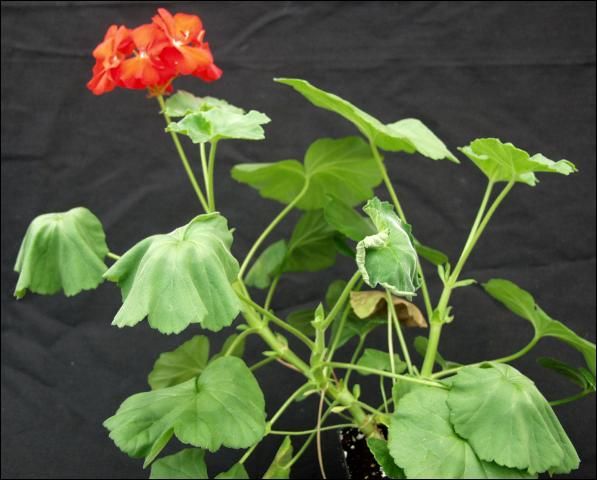
Credit: Dave Norman
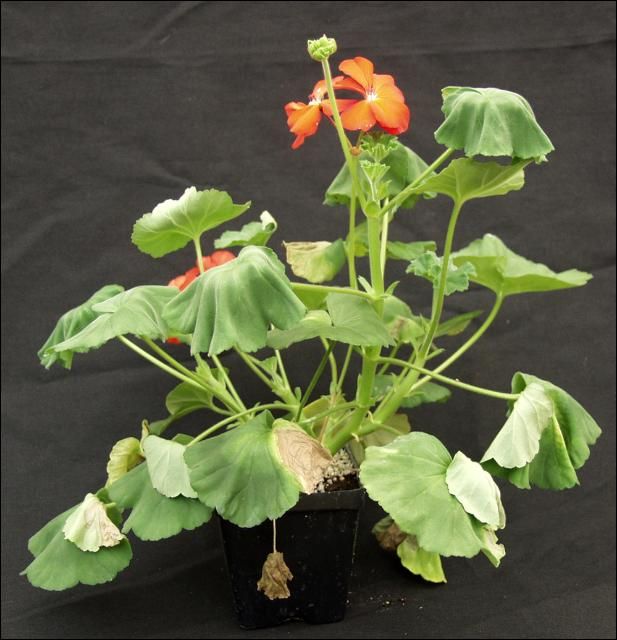
Credit: Dave Norman
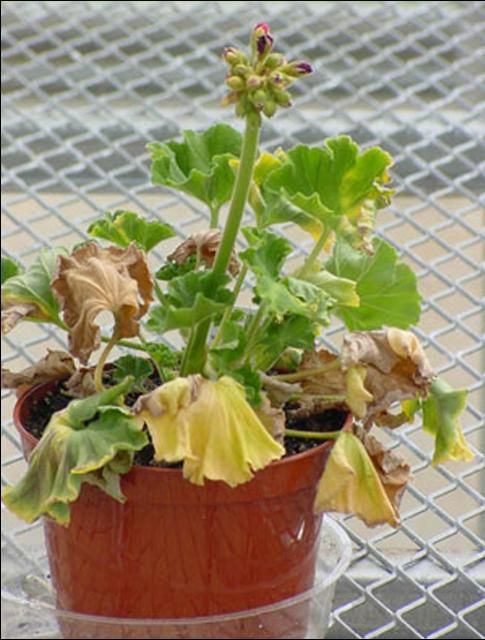
Credit: Tim Momol
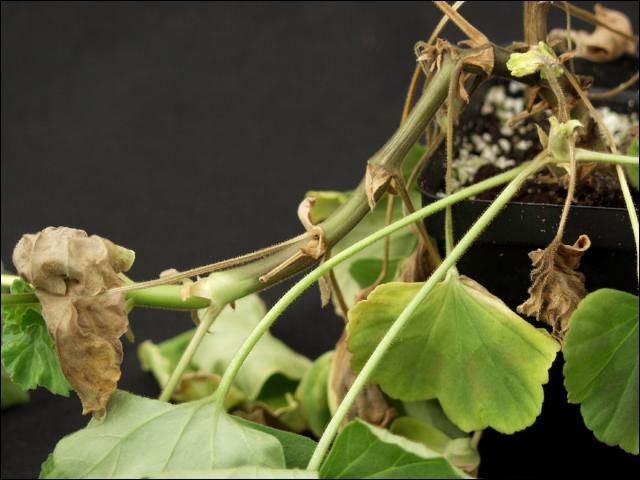
Credit: Dave Norman
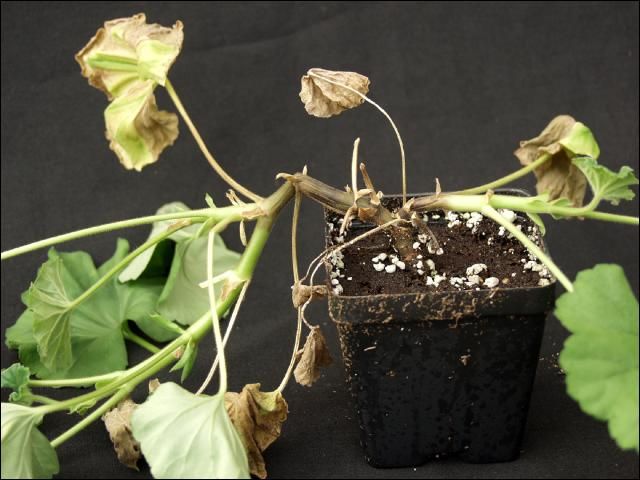
Credit: Dave Norman
Look-alikes
Similar wilt symptoms may be caused by general root rot, various nutrient imbalances, or water stress. Bacterial blight caused by Xanthomonas campestris pathovar pelargonii also may cause wilt symptoms. Generally, leaves affected with bacterial blight will become spotted, vascular discoloration will be less pronounced or absent, and roots will remain white and healthy.
Spread of the Pathogen
R. solanacearum race 1 can be found in soils of the southern US, including Florida. Plants brought into a facility from native soil plantings could introduce the pathogen. Soil tracked into a facility on equipment, shoes, or supplies could also contain the bacterium. In addition to being soil-borne, Rs can be water-borne. The pathogen was detected in irrigation ponds and surface water in Quincy Florida in 2004 (Tim Momol, personal communication). Rs has the potential to move into recycled irrigation water from infected weed species in close association with water collection or recovery areas. Since RsR3b2 is a quarantinable pathogen in the US, pathogen introduction from overseas production facilities in Central America and Kenya is the main concern for geranium producers. Once introduced into a production facility, RsR3b2 can be transmitted through contaminated irrigation water, on equipment, by personnel, or in soil similar to race 1.
Shared irrigation systems (i.e. flooded benches or floors) facilitate spread of the bacterium within a production facility. When contaminated irrigation water is used on geranium and other susceptible hosts, the pathogen moves with the water to the roots where it infects. The bacterium may be present in the water-conducting tissues (vascular tissue). If an infected plant is pruned with tools or pinched by hand, the bacterium can be spread to subsequent healthy plants. The pathogen also can be spread by splashing irrigation water. Though possible, the pathogen does not readily spread through leaf-to-leaf contact or through still water vapor in the air.
Risk Reduction and Disease Management
The introduction and discovery of this pathogen in a geranium production facility could have serious financial consequences. Some basic disease management strategies, including exclusion, sanitation, and eradication, can reduce the risk of pathogen introduction and spread. These practices can not only reduce the likelihood of many diseases but can reduce the potential financial impact of an introduction.
Inspect Offshore Plant Material
RsR3b2 is a regulated pathogen in the United States (http://www.gpo.gov/fdsys/pkg/FR-2012-10-05/pdf/2012-24434.pdf). Many geranium cuttings are produced in areas of the world where the pathogen is common. Movement of infected cuttings from these areas into US production facilities has occurred despite an APHIS-mandated testing and sampling plan for offshore facilities shipping geranium to the US. Careful producers will take additional precautions to ensure they receive clean material.
Rooted geranium cuttings imported from overseas initially should be isolated from the rest of the production facility for at least 48 hours if possible. Latent infections are difficult to detect, but plants should be carefully inspected for general wilting symptoms commonly associated with bacterial diseases (see Figures). If a shared irrigation system is used for the rest of the production facility, try to provide an alternate means of irrigation separate from the main system.
Growers with symptomatic plants have two diagnostic options.
- Growers could test symptomatic plants themselves with a serological kit. Serological kits for detecting R. solanacearum are available from a handful of companies. Agdia (http://www.agdia.com), for example, offers ImmunoStrip testing kits (catalog number: ISK 33900/0025). These kits cost from $4.80 to $7.50 per test depending on how many are purchased, take about 30 min to complete, and can be ordered online or by phone. Detailed information about the kits, how they should be used, and a copy of the instructions are available on the Agdia website. The kits also come with easy-to-follow instructions that include illustrations. Other companies with serological kits include: Neogen Europe Ltd., Bioreba AG, Pocket Diagnostic, and Loewe Biochemica GmbH.
- Growers can also send samples to a UF/IFAS Extension Plant Diagnostic Center for confirmation (https://edis.ifas.ufl.edu/sr007). Growers are encouraged to consult with UF/IFAS plant pathologists regarding any possible plant disease issues prior to submitting samples for testing.
RsR3b2 is listed as a "Select Agent" under the Federal regulation on Agricultural Bioterrorism Protection Act of 2002 (7 CFR Part 331). This designation indicates that RsR3b2 represents a significant threat to American agriculture. If a serological kit is used and a plant is found to be positive, submit a sample to a UF/FAS Extension Plant Diagnostic Center and contact your state Division of Plant Industry inspector for further instruction. Federal law requires that positive samples must be reported to the appropriate regulatory agencies for confirmation of race and biovar. Several tests are used to confirm race and biovar of the pathogen (via PCR, carbohydrate utilization, etc.). In the event that the pathogen is found, measures will be taken to contain and eliminate it from the production system.
Reducing Risk of Spread
A common means of disease transmission is bacterial survival in irrigation water. Best management practices are to avoid bottom-water (sub) irrigation that uses a continuous flow of water to irrigate many plants at the same time. Also avoid systems that collect excess water and return the used water to the system. Though these systems have their advantages, they do increase the likelihood of the spread of bacterial pathogens and in the case of Rs, increase the likelihood of substantial losses. When possible, use drip irrigation or mist irrigation instead.
If rain water is collected into holding tanks, if water is taken from collection or overflow ponds, or if water is recycled and reused, incorporate some type of water treatment that will help reduce bacterial pathogens. For example, ozonating sanitizers have been shown to remove Rs from contaminated irrigation water by 0.4 ppm residual O3 for 4 minutes with UV light of at least 300 j/m2 at >50% transmission. Various other filters and treatments are available to help remove pathogens from irrigation water. To prevent continued introduction of pathogens into the source, areas directly around collection ponds, open holding tanks, and greenhouses should be kept free of weeds. Plants or cuttings from plants that have been in contact with native soil also should be kept out of the greenhouse.
Plants found to be under the drip line of infected geraniums are typically discarded if Rs is detected. To be safe, don't place other plants under geraniums in the greenhouse. Keep geraniums on well-drained benches and off the ground or plastic sheeting where water may collect and pool. Keep plants from different sources and different varieties of geranium as separate as possible. When pruning, grooming, or making cuttings, workers should frequently sanitize hands and tools. This is especially important when moving between varieties, benches, and houses. Sanitizing hand gel dispensers and spray bottles with sanitizing cleaners are very useful. Locate sanitizing shoe baths at the entrances of production facilities to reduce the likelihood of introducing pathogens in soil on shoes. Examples of cleansers commonly used to sanitize tools, pots, benches, shoes, and walkways include Physan 20, Green Shield, Maquat 615-HD or -LR, and ZeroTol. Follow the label instructions of these and other chemical disinfectants. Infected plant material should be burned or sterilized with steam using an autoclave. Large amounts of infected waste should be disposed of in an approved landfill.
Hopefully no one reading this document will ever have to deal with an RsR3b2 introduction. Unfortunately, even if all these recommendations are followed, the risk of substantial losses may be reduced but cannot be eliminated completely. For additional information on RsR3b2, the regulatory actions associated with this pathogen, and other recommendations, visit the APHIS PPQ website for the latest Ralstonia solanacearum race 3 biovar 2 Pest Response Guidelines at: http://www.aphis.usda.gov/wps/portal/aphis/ourfocus/importexport?1dmy&urile=wcm%3apath%3a%2Faphis_content_library%2Fsa_our_focus%2Fsa_plant_health%2Fsa_domestic_pests_and_diseases%2Fsa_pests_and_diseases%2Fsa_plant_disease%2Fsa_ralstonia%2Fct_ralstonia.
Related Resources
UF/IFAS Extension Electronic Data Information Source (EDIS) https://edis.ifas.ufl.edu/
APHIS PPQ Ralstonia pest response guidelines: https://www.aphis.usda.gov/aphis/ourfocus/planthealth/sa_domestic_pests_and_diseases/sa_pests_and_diseases/sa_plant_disease/sa_ralstonia/
Bacterial wilt of row crops in Florida: https://plantpath.ifas.ufl.edu/media/plantpathifasufledu/factsheets/circ1207.pdf
First Report of Southern Wilt Caused by Ralstonia solanacearum on Geranium in Florida. P. Pradhanang, T. Momol, H. Dankers, E. Momol, and J. Jones. http://www.plantmanagementnetwork.org/sub/php/brief/geranium/
Professional Disease Management Guide for Ornamental Plants https://edis.ifas.ufl.edu/pdffiles/PP/PP12300.pdf
Southern Plant Disease Network (SPDN) http://www.sepdn.org/
UF/IFAS Pest Alerts: http://blogs.ifas.ufl.edu/pestalert/#
UF/IFAS Extension Plant Diagnostic Center: https://edis.ifas.ufl.edu/SR007 https://plantpath.ifas.ufl.edu/extension/plant-diagnostic-center/
UF/IFAS Department of Plant Pathology, Extension Fact Sheets: https://plantpath.ifas.ufl.edu/extension/fact-sheets/